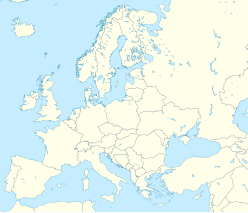Ilumetsa crater
| Ilumetsa crater | |
|---|---|
 Ilumetsa crater | |
| Impact crater/structure | |
| Confidence | Probable |
| Diameter | 80 m (260 ft) |
| Age | 7 ka |
| Exposed | Yes |
| Drilled | Yes |
| Location | |
| Coordinates | 57°57′36.17″N 27°24′10.43″E / 57.9600472°N 27.4028972°E |
| Country | Estonia |
Ilumetsa is a set of two probable meteorite craters[1] in Estonia. [ambiguous]
The Ilumetsa site is located in south eastern Estonia and it consists of two structures, located 725 m from each other. Their diameters are: 75–80 m and ~50 m. Their true depths are about 8 and 3.5 m, respectively.[2] Both structures are surrounded by a rim up to a few meters high: the rims are highest in their eastern parts with maximum rim heights of Ilumetsa Large 4.5 m and 1.5 m for Ilumetsa Small.
The Large Ilumetsa structure has been dated by radiocarbon dating the gyttja and peat from the very bottom of the crater shaped depression.[3] The lowermost organic beds were dated to 6030 +/-100 14C years (7170– 6660 cal. years BP). Recent radiocarbon dating charcoals buried within assumed proximal ejecta blankets of these crater-like features showed Ilumetsa Large and Ilumetsa Small formed simultaneously between 7170 and 7000 cal. years BP.[4]
No clear meteorite fragments or shock metamorphic effects were ever found around those structures. Because of that Ilumetsa is not a proven impact crater. However, indirect lines of evidence are enough to call it a "probable" impact site. It is: 1) presence of deformed sedimentary beds (including the rim consisting of sands mixed with numerous clayey till lenses;[5], 2) only a small thickness of glacial sediments,[2] 3) simultaneous formation of both structures as showed by radiocarbon dating.[4]
References[edit]
- ^ Osinski, Gordon R.; Grieve, Richard A. F.; Ferrière, Ludovic; Losiak, Ania; Pickersgill, Annemarie; Cavosie, Aaron J.; Hibbard, Shannon M.; Hill, Patrick; Bermudez, Juan Jaimes; Marion, Cassandra L.; Newman, Jennifer D. (2022-07-21). "Impact Earth: A review of the terrestrial impact record". Earth-Science Reviews. 232: 104112. Bibcode:2022ESRv..23204112O. doi:10.1016/j.earscirev.2022.104112. ISSN 0012-8252. S2CID 250965097.
- ^ a b Plado, Jüri (October 2012). "Meteorite impact craters and possibly impact-related structures in Estonia: Meteorite impact record of Estonia". Meteoritics & Planetary Science. 47 (10): 1590–1605. doi:10.1111/j.1945-5100.2012.01422.x. S2CID 129740410.
- ^ Liiva A., Kessel H., and Aaloe A. (1979). "Age of the Ilumetsa craters. (in Estonian)". Eesti Loodus. 12: 762–764.
{{cite journal}}: CS1 maint: multiple names: authors list (link) - ^ a b Losiak, A.; Jõeleht, A.; Plado, J.; Szyszka, M.; Kirsimäe, K.; Wild, E. M.; Steier, P.; Belcher, C. M.; Jazwa, A. M.; Helde, R. (February 2020). "Determining the age and possibility for an extraterrestrial impact formation mechanism of the Ilumetsa structures (Estonia)". Meteoritics & Planetary Science. 55 (2): 274–293. Bibcode:2020M&PS...55..274L. doi:10.1111/maps.13431. ISSN 1086-9379. S2CID 213799334.
- ^ Aaloe A. (1963). "New data on the structure of Ilumetsa craters. (in Russian)". Eesti NSV Teaduste Akadeemia Geoloogia Instituudi Uurimused (11): 35–43.



